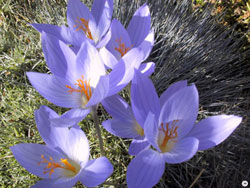 A familiar flower blooming in what seems to be the wrong season is always a source of surprise and curiosity. Such a plant is the fall-blooming crocus that provides a burst of unexpected color in the autumn garden.
A familiar flower blooming in what seems to be the wrong season is always a source of surprise and curiosity. Such a plant is the fall-blooming crocus that provides a burst of unexpected color in the autumn garden.
How many different crocus’ are there?
Technically members of the iris family, there are more than a dozen species of crocuses that bloom in fall and winter. Hybridizers have concentrated on the familiar spring-blooming crocus, and they now outnumber the fall bloomers.
What are the differences between types of crocus?
Crocus sativus, known as the saffron crocus, is probably the most familiar due to its history of culinary, dye, and medicinal uses. When blooming, the flower is only 2½ inches tall and is tucked in among its tall, narrow leaves. At 6-7 inches tall, Crocus speciosus is larger than the saffron crocus and blooms a bit earlier. As the leaves emerge after the flowers, the blossoms appearing from the soil or among the fallen leaves of deciduous tree is very dramatic. Several hybrid varieties of C. speciosus are available as well as the straight species. Other fall-flowering crocus species include C. goulimyi, C. kotschyanus, C. medius, C. pulchellus, and C. ochroleucus. These less common species of crocus can be obtained through mail-order bulb companies. They also may also be available at local garden centers and nurseries. All crocuses mentioned here are hardy to USDA zone five.
How should I plant crocus’?
Crocus bulbs are technically corms and are planted during the brief July and August dormant period. The small corms should be set with flattest side down in the soil at a depth of 3½ to 4 inches. Given their diminutive size, crocus displays are most effective when planted in mass. Most crocuses do best when planted in an area that receives full sun has well-drained soil. A few species will tolerate light shade.
Also referred to as “fall-blooming crocus” are corms from the genus Colchicum. The flowers of these plants are very similar to Crocus but their growth cycle differs slightly. Colchicum have broad leaves that grow briefly in the spring and then die by midsummer. In the fall, leafless flower stalks rise to produce clusters of flaring, four-inch purple flowers. Do not confuse these with the saffron crocus as most parts of the Colchicum plant are poisonous.
For more information, see the following Planttalk Colorado™ video(s).
For more information, see the following Planttalk Colorado™ script:
For more information, see the following Colorado State University Extension fact sheet: Fall Planted Bulbs and Corms # 7.410.



